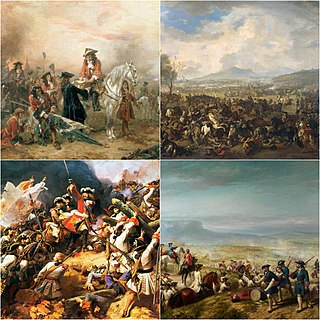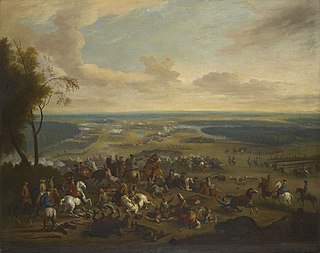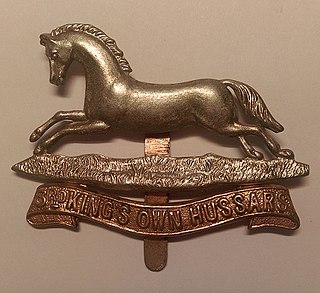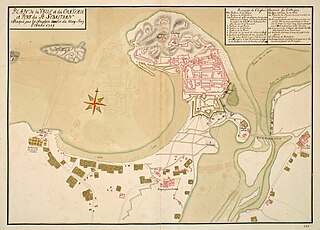
The War of the Spanish Succession was a European great power conflict fought between 1701 and 1714. The immediate cause was the death of the childless Charles II of Spain in November 1700, which led to a struggle for control of the Spanish Empire. His nominated heir was Philip of Anjou, a grandson of Louis XIV of France, whose main backers were France and most of Spain. His rival, Archduke Charles of Austria, was supported by the Grand Alliance, whose primary members included the Holy Roman Empire, the Dutch Republic, and Great Britain. Significant related conflicts include the 1700 to 1721 Great Northern War, and Queen Anne's War in North America.

The Battle of Almansa took place on 25 April 1707, during the War of the Spanish Succession. It was fought between an army loyal to Philip V of Spain, Bourbon claimant to the Spanish throne, and one supporting his Habsburg rival, Archduke Charles of Austria. The result was a decisive Bourbon victory that reclaimed most of eastern Spain for Philip.

The Battle of Denain was fought on 24 July 1712 as part of the War of the Spanish Succession. It resulted in a French victory, under Marshal Villars, against Dutch and Austrian forces, under Prince Eugene of Savoy.

The Battle of Malplaquet took place on 11 September 1709 during the War of the Spanish Succession, near Taisnières-sur-Hon in modern France, then part of the Spanish Netherlands. A French army of around 75,000 men, commanded by the Duke of Villars, engaged a Grand Alliance force of 86,000 under the Duke of Marlborough. In one of the bloodiest battles of the 18th century, the Allies won a narrow victory, but suffered heavy casualties.

The siege of Haarlem was an episode of the Eighty Years' War. From 11 December 1572 to 13 July 1573 an army of Philip II of Spain laid bloody siege to the city of Haarlem in the Netherlands, whose loyalties had begun wavering during the previous summer. After the naval battle of Haarlemmermeer and the defeat of a land relief force, the starving city surrendered and the garrison was massacred. The resistance nonetheless was taken as an heroic example by the Orangists at the sieges of Alkmaar and Leiden.

The Battle of Almenar also referred to as Almenara was a battle in the Iberian theatre of the War of the Spanish Succession.

The siege of Toulon took place between 29 July to 21 August 1707 during the War of the Spanish Succession, when a combined Savoyard-Imperial army supported by a British naval force, attacked the French base at Toulon.

The 3rd Hussars was a cavalry regiment of the British Army, first raised in 1685. It saw service for three centuries, including the First and the Second World Wars, before being amalgamated with the 7th Queen's Own Hussars, to form the Queen's Own Hussars in November 1958.

The siege of Lille was the salient operation of the 1708 campaign season during the War of the Spanish Succession. After an obstinate defence of 120 days, the French garrison surrendered the city and citadel of Lille, commanded by Marshal Boufflers, to the forces of the Duke of Marlborough and Prince Eugene.

The capture of Gibraltar by Anglo-Dutch forces of the Grand Alliance occurred between 1 and 4 August 1704 during the War of the Spanish Succession. Since the beginning of the war the Alliance had been looking for a harbour in the Iberian Peninsula to control the Strait of Gibraltar and facilitate naval operations against the French fleet in the western Mediterranean Sea. An attempt to seize Cádiz had ended in failure in September 1702, but following the Alliance fleet's successful raid in Vigo Bay in October that year, the combined fleets of the 'Maritime Powers', the Netherlands and England, had emerged as the dominant naval force in the region. This strength helped persuade King Peter II of Portugal to sever his alliance with France and Bourbon-controlled Spain, and ally himself with the Grand Alliance in 1703 as the Alliance fleets could campaign in the Mediterranean using access to the port of Lisbon and conduct operations in support of the Austrian Habsburg candidate to the Spanish throne, the Archduke Charles, known to his supporters as Charles III of Spain.

The siege of Barcelona took place between 14 September and 19 October 1705 during the War of the Spanish Succession when a multinational Grand Alliance army led by Lord Peterborough, supporting the Habsburg pretender to the Spanish throne, captured the city of Barcelona from its Spanish Bourbonic defenders, most of whom then joined the Habsburg army.

The siege of Pensacola included two separate attempts in 1707 by English-supported Creek Indians to capture the town and fortress of Pensacola, one of two major settlements in Spanish Florida.

One of the worst bombing attacks on civilian population in Alicante during the Spanish civil war. This particular attack was one of many against the Spanish city of Alicante and it occurred on 25 May 1938, perpetrated by the Legionary Air Force, an expeditionary corps from the Italian Royal Air Force, allied with Franco. The attacking planes were based in Mallorca. It is even considered by many to be one of the deadliest aerial bombings of the entire Spanish Civil War with many bombs dropped on a strictly civilian population with no military targets within a short amount of time. It was heavily reported by witnesses that the planes dove low shooting at civilians randomly.
The siege of Dublin took place in 1649 during the Irish Confederate Wars. It was a failed attempt by combined Irish Royalist and Confederate forces to capture the capital of Dublin which was held by English Republican forces under Michael Jones. It was part of a strategy by Duke of Ormonde, head of an alliance loyal to Charles II, to seize the remaining foothold of Ireland still under the control of the London Parliament.

No Peace Without Spain was a popular British political slogan of the early eighteenth century. It referred to the ongoing War of the Spanish Succession (1701–1714) in which Britain was a leading participant. It implied that no peace treaty could be agreed with Britain's principal enemy Louis XIV of France that allowed Philip, the French candidate, to retain the Spanish crown. The term became a rallying cry for opposition to the Tory government of Robert Harley, Earl of Oxford and the terms of the Treaty of Utrecht.
Jacob Richards was an Irish soldier of the seventeenth century known for his service with the English Army. In the War of the Two Kings in Ireland he fought for William III against the Jacobite Irish Army of James II. During the campaign he was Chief Engineer with charge of the Royal Artillery.
John Richards (1669–1709) was an Irish soldier and artillery commander. He served in the Portuguese Army during the War of the Spanish Succession and was killed when a mine was detonated by the enemy while in command of the defence at the Siege of Alicante.

The siege of San Sebastián took place in 1719 during the War of the Quadruple Alliance when French forces under the Duke of Berwick successfully laid siege to the Spanish city of Siege of San Sebastián close to the French border. Combined with the British Attack on Vigo, this led the Spanish to seek peace terms and the war ended with the agreement of the Treaty of The Hague in 1720.

The siege of Tournai was a siege of the city of Tournai, then part of the Kingdom of France, between 28 June and 3 September 1709. A Grand Alliance army under the British Duke of Marlborough successfully forced the surrender of the French garrison during the War of the Spanish Succession.

The siege of Mons took place between 19 September and 23 October 1709 during the War of the Spanish Succession. It saw a Franco-Spanish garrison in the fortified town of Mons, then in the Spanish Netherlands, besieged by a force of the Duke of Marlborough's Grand Alliance army under the command of the Prince of Orange.
















